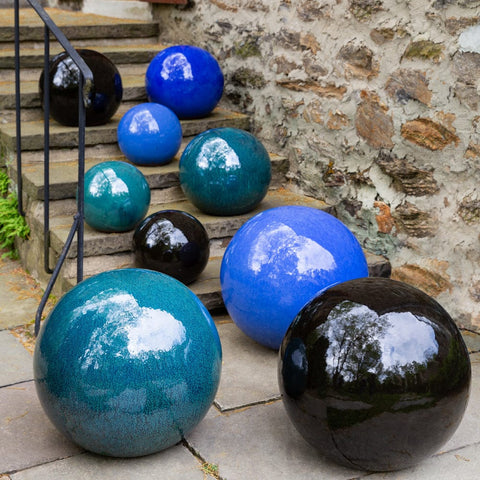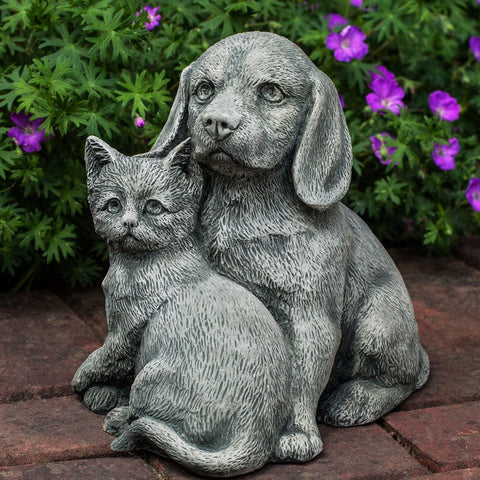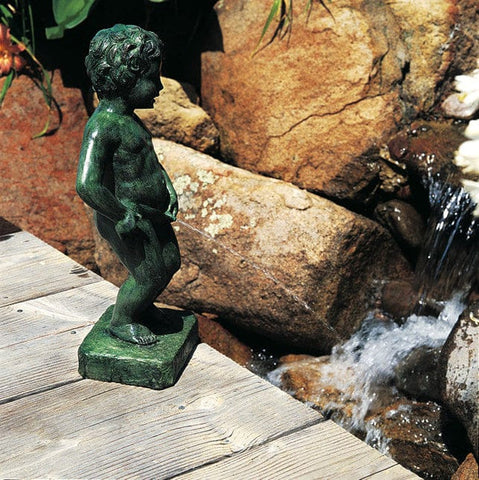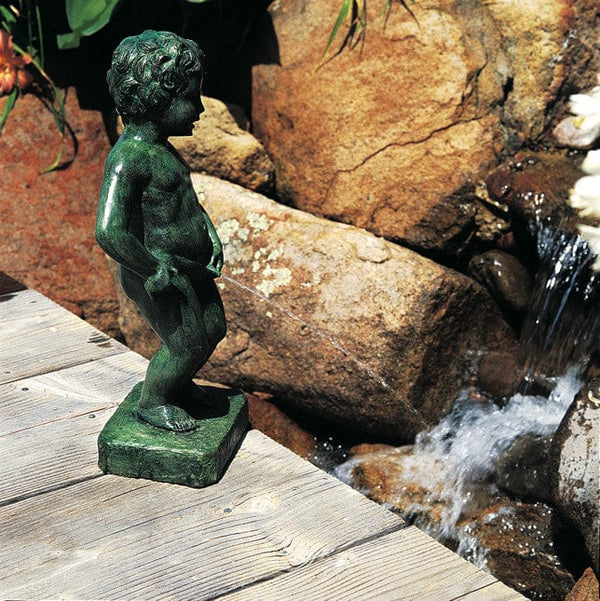Garden statues and sculptures can add a touch of elegance and charm to any outdoor space. However, keeping them clean and well-maintained can be a challenge, especially if they are made of delicate materials or are exposed to harsh weather conditions. In this article, we will provide some useful tips and tricks on how to clean and maintain garden statues and sculptures, so that they can continue to enhance the beauty of your garden for years to come.
When it comes to cleaning garden sculptures and statues, the first step is to identify the material they are made of. Different materials require different cleaning methods and products. For instance, marble statues should be cleaned with a mild soap and water solution, while bronze sculptures may require a specialized metal cleaner. It is important to read the manufacturer's instructions carefully and avoid using abrasive or acidic cleaners that can damage the surface of the statue.
In addition to regular cleaning, it is also important to maintain garden statues and sculptures by protecting them from the elements. This includes covering them during harsh weather conditions such as storms or extreme heat, and applying a protective sealant to prevent rust or corrosion. By following these simple steps, you can ensure that your garden statues and sculptures remain beautiful and well-preserved for many years to come.

Understanding the Materials
When it comes to cleaning and maintaining garden statues and sculptures, it is important to understand the materials they are made of. Different materials require different cleaning methods and care. Here are the most common materials used for garden statues and sculptures:
Stone and Concrete Statues
Stone and concrete statues are durable and can withstand harsh weather conditions. However, they can become discolored over time due to exposure to the elements. To clean stone and concrete statues, use a soft-bristled brush and mild detergent mixed with water. Avoid using harsh chemicals or high-pressure washers, as they can damage the surface of the statue. To prevent future discoloration, consider applying a sealant to the statue.
Metal Sculptures
Metal sculptures, such as bronze, iron, and lead, are prone to rust and corrosion. To clean metal sculptures, use a soft cloth and mild detergent mixed with water. Avoid using abrasive materials or harsh chemicals, as they can scratch or damage the surface of the sculpture. To prevent rust and corrosion, apply a coat of wax or oil to the sculpture.
Wood and Resin Figures
Wood and resin statues are susceptible to cracking and fading. To clean wood and resin statues, use a soft cloth and mild detergent mixed with water. Avoid using high-pressure washers or harsh chemicals, as they can damage the surface of the statue. To prevent cracking and fading, apply a coat of sealant or varnish to the statue.
In summary, understanding the materials used for garden statues and sculptures is essential for proper cleaning and maintenance. By using the appropriate cleaning methods and care, you can ensure that your statues and sculptures remain in pristine condition for years to come.
How to Clean and Maintain Your Garden Statues and Sculptures

1. Dusting and Wiping
Dusting and wiping the surface of the statue with a soft cloth or brush is a simple and effective way to remove dirt and grime. Use a dry, soft cloth to gently wipe the surface of the statue. For hard-to-reach areas or intricate designs, use a soft-bristled brush to remove dust and debris.
2. Washing with Soap and Water
For more thorough cleaning, washing the statue with soap and water is recommended. Fill a bucket of water and add a few drops of mild detergent or liquid dish soap. Use a soft cloth or sponge to gently scrub the surface of the statue. Rinse thoroughly with a garden hose or clean water to remove any soap residue.
3. Addressing Mold and Mildew
If you notice mold or mildew growing on the surface of the statue, it's important to address it promptly. Use a mixture of water and mild detergent or liquid dish soap to clean the affected area. For stubborn mold or mildew, use a scrub brush to gently remove it. Rinse thoroughly with clean water and allow the statue to dry completely.
Remember to always use gentle cleaning methods and avoid harsh chemicals or abrasive materials that can damage the surface of the statue.
4. Preparing for Winter
As the colder months approach, it's important to apply winter care tips and prepare your garden statues and sculptures for the freezing temperatures ahead. To avoid damage from frost and ice, it's recommended to remove any water or moisture from the sculpture's surface. This can be done by gently wiping the sculpture with a dry cloth or using a power washer on a low setting.
Additionally, it's recommended to apply a protective finish to the sculpture's surface to help seal it from the elements. A sealant such as polyurethane can be applied to the surface to help prevent moisture from penetrating the sculpture's surface. This will also help protect the sculpture from harsh chemicals and UV rays from the sun.
5. Protecting from the Elements
While garden sculptures are designed to withstand the elements, prolonged exposure to rain, sun, and harsh chemicals can cause damage over time. To protect your garden sculptures from these elements, it's recommended to apply a protective finish to the surface of the sculpture. This can be done using a sealant or a protective wax.
It's also important to avoid using harsh chemicals or power washers on the sculpture's surface, as this can cause damage to the protective finish and the sculpture itself. Instead, use a gentle soap and water solution to clean the sculpture's surface, and avoid leaving the sculpture in direct sunlight for extended periods of time.

6. Fixing Cracks and Damage
If your garden statue or sculpture has cracks or other damages, the first step is to clean the surface thoroughly. Use a gentle cleaning solution, such as a mixture of water and bleach, to remove any dirt or mold growth. Once the surface is clean, use sandpaper or a wire brush to remove any loose or chipped paint.
To fix cracks and other damages, use a polyurethane or epoxy-based adhesive. Apply the adhesive to the damaged area and use a clamp or other tool to hold the pieces together until the adhesive sets. Once the adhesive has set, use sandpaper to smooth out any rough edges.
7. Reapplying Finishes and Paint
After repairing any damages, it's important to reapply finishes and paint to protect the surface and restore its appearance. Start by applying a thin coat of wax to the surface to protect it from moisture and other elements.
If the statue or sculpture has paint, use a high-quality outdoor paint that is formulated for the material of the statue. Apply the paint in thin, even coats, allowing each coat to dry completely before applying the next. If the statue has a fountain or other water feature, make sure to use a waterproof paint.
8. Buffing and Polishing
Buffing and polishing are techniques used to remove scratches, stains, and other imperfections from the surface of garden statues and sculptures. To buff and polish a statue, one can use a soft cloth or a bristle brush along with a buffing compound or polishing paste. It is important to use a gentle touch and avoid applying too much pressure, as this can damage the statue's surface.
Before buffing and polishing, it is important to clean the statue thoroughly to remove any loose dirt or debris. Research the statue's material and use appropriate cleaning products to avoid damaging it. For example, vinegar and water can be used to clean a garden statue made of stone or concrete, while a grease-cutting cleaner may be necessary for a metal statue.
9. Applying Wax and Sealers
Applying wax and sealers is another way to enhance the appearance of garden statues and sculptures. Wax can be used to protect the statue's surface from moisture and other environmental factors, while sealers can help to prevent fading and discoloration.
Before applying wax or sealer, make sure the statue is clean and dry. Use a sprayer nozzle to apply a thin, even layer of wax or sealer to the statue's surface. Allow the wax or sealer to dry completely before buffing it with a soft cloth or bristle brush.
Conclusion
Cleaning and maintaining garden statues and sculptures is an important task that should not be overlooked. By following the steps outlined in this article, one can ensure that their garden decor remains in top condition for years to come.
It is important to keep in mind that different materials require different cleaning methods. For example, plastic statues can be cleaned with soap and water, while stone statues may require a more gentle approach. Additionally, regular maintenance is key to preventing damage and prolonging the life of the statue.
Overall, taking the time to properly care for garden statues and sculptures can make a big difference in their appearance and longevity. With the right information and tools, anyone can keep their outdoor decor looking beautiful and well-maintained.

